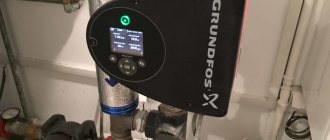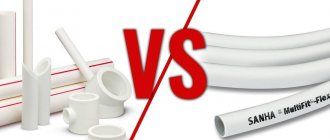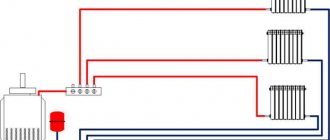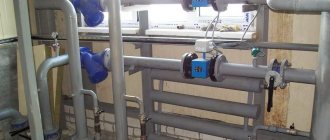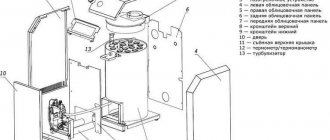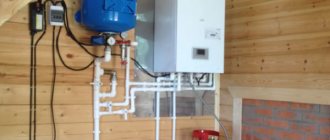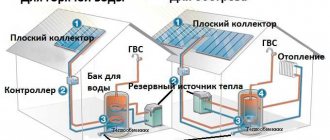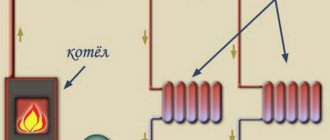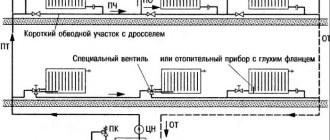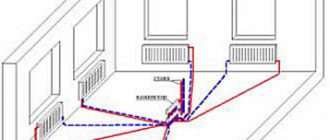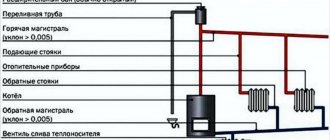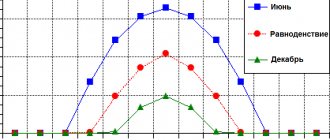Types of Vacuum Tubes
There are five types of vacuum tubes for solar collectors. They differ in internal structure and design. In addition, each of them can be supplemented with a metal (usually aluminum) absorber, which is placed inside a glass flask in the form of a tube.
Important! Most manufacturers fill the lower gap between the glass walls with barium - it absorbs gas impurities and improves thermal insulation properties. Its absence can reduce the efficiency of the collector by up to 15%.
Thermosyphon (open) vacuum tubes
This type of solar collector tubes is used in collectors with an external storage tank. they are filled with water and form one volume with the tank. Heated water from the flask rises into the tank, and cooled water goes down.
Thermosiphon vacuum manifolds are used in the following cases:
- For connection to the hot water supply system;
- In regions with high levels of insolation during the cold season;
- For seasonal use (spring, summer, autumn).
Coaxial tube (Heat Pipe)
This is the most common type of vacuum tube. In it, inside a glass flask there is a copper pipe filled with a liquid with a low boiling point or water under low pressure.
When heated, the liquid or water begins to boil, the steam rises, simultaneously heating up from the copper walls. At the top, it enters a heat exchanger - an expansion at the end, in which it transfers heat through the walls to the water that circulates around it.
After cooling, the steam condenses on the walls of the heat exchanger and flows down. The cycle repeats again.
Schematic internal structure of a coaxial tube and heat exchanger.
Twin coaxial tubes
The principle of operation of such a heat receiver is the same as the previous one, with one exception - two copper tubes with liquid are connected to one heat exchanger. The twin system allows for more efficient heat removal, and the large capacity and wall area of the heat exchanger allows for quick heating of water.
Vacuum manifolds with a paired coaxial system are installed where necessary:
- Provide small heating of large volumes of water;
- There is a need for thermal energy during a sunny day;
- High average level of insolation;
- Water is quickly pumped through the system.
Feather Vacuum Tubes
Their design includes an additional heat exchanger, which allows for more efficient heat removal from the inside of the glass bulb. Usually it is made in the form of two longitudinal plates located on the sides of the copper heat sink.
Otherwise, the operating principle is exactly the same as that of a coaxial tube.
U-shaped vacuum tubes (U-type)
This system is radically different from the previous ones. It uses two lines - for cold and heated water.
A heat exchanger in the shape of the English letter U is installed in a glass flask, through which water passes. From the main line with cold water, it enters it, heats up and returns to the pipe with heated water.
A U-tube manifold is the most efficient, but can be difficult to install. During assembly, the flow lines are attached by welding to copper tubes located inside the glass flask. The result is a single integral system with high energy efficiency, but low maintainability.
Mounting the flask onto a U-shaped copper tube.
What types of solar collectors are there?
There are two types of such systems: flat and vacuum. But, at their core, their operating principles are similar. They use the sun's heat to heat water. They differ only in the device. Let's look at the operating principles of these types of solar systems in more detail.
Flat
This is the simplest and cheapest type of collector. It works as follows: The metal body, which is internally treated with a highly efficient feather absorber to absorb heat, contains copper tubes. A coolant (water or antifreeze) circulates through them, which absorbs heat. Next, this coolant passes through a heat exchanger in a storage tank, where it transfers heat directly to the water that we can use, for example, to heat a house.
The upper part of the system is covered with high-strength glass. All other sides of the body are insulated with insulation to reduce heat loss.
| Advantages | Flaws |
| Low cost panels | Low efficiency, approximately 20% lower than vacuum |
| Simple design | Large amount of heat loss through the body |
Because of their ease of manufacture, such systems are often made even with their own hands. You can purchase the necessary materials at construction stores.
Vacuum
These systems work a little differently, this is due to their design. The panel consists of double tubes. The outer tube plays a protective role. They are made of high-strength glass. The inner tube has a smaller diameter and is covered with an absorber that accumulates solar heat.
This heat is then transferred to pullers or rods made of copper (they come in several types and have different efficiencies, we’ll look at them a little later). Heat extractors transfer heat using a coolant to a storage tank.
There is a vacuum between the tubes, which reduces heat loss to zero and increases the efficiency of the system.
| Advantages | Flaws |
| High efficiency | Higher price relative to flat |
| Minimum heat loss | Impossibility of repairing the tubes themselves |
| Easy to repair, tubes can be changed one unit at a time | |
| Large selection of species |
Types of heat removable elements (absorbers), out of a total of 5
- Feather absorber with direct-flow heat channel.
- Feather absorber with heat pipe.
- U-shaped direct-flow vacuum manifold with coaxial flask and reflector.
- System with a coaxial bulb and a heat pipe.
- The fifth system is flat-plate collectors.
Let's look at the operating efficiency of different absorbers, and also compare them with flat-plate collectors. Calculations are given for 1 m2 of panel.
This formula uses the following values:
- η is the efficiency of the collector, which we calculate;
- η₀ - optical efficiency;
- k₁ - heat loss coefficient W/(m²·K);
- k₂ - heat loss coefficient W/(m²·K²);
- ∆T - temperature difference between the collector and air K;
- E – total intensity of solar radiation.
Using this formula, using the data given above, you can do the calculations yourself.
Without delving into the variables, to put it simply, efficiency depends on the amount of heat absorbed by the copper heat sinks and the amount of loss by the system.
Systems with flow-through heaters or thermosiphon
According to their structure, they can be either flat or vacuum. They use the same operating principles. However, they have one significant difference in technical design.
This system can operate without an additional backup storage tank and pump group.
The operating principle is as follows. The heated coolant is accumulated in the base tank, which is located at the top of the system, usually 300 liters. A coil passes through it, through which water circulates from the pressure of the house’s plumbing system itself. It warms up and is supplied to the consumer.
| Advantages | Flaws |
| Low cost due to the absence of some equipment. | Low system efficiency in the winter season and at night |
| Easy to install, requires minimal effort, as the system is equipped with everything necessary |
Pros and cons of vacuum type collectors
The main advantage of the units is the almost complete absence of heat loss during operation. This is provided by a vacuum environment, which is one of the highest quality natural insulators. But the list of advantages does not end there. The devices have other distinct advantages, for example:
- operating efficiency at low temperatures (down to -30 °C);
- ability to accumulate temperatures up to 300°C;
- maximum possible absorption of thermal energy, including the invisible spectrum;
- operational stability;
- low susceptibility to aggressive atmospheric manifestations;
- low windage due to the design features of tubular systems capable of passing air masses of different densities through them;
- high level of efficiency in regions with temperate and cool climates with a small number of clear and sunny days;
- durability subject to basic operating rules;
- accessibility for repair and the ability to change not the entire system, but only one failed fragment.
The disadvantages include the inability of the collectors to self-clean from frost, ice, snow and the high price of the components necessary to assemble the unit at home.
What to look for when purchasing
Before purchasing a solar water heater, be sure to analyze the expected operating conditions. Pay attention to the following design features:
- The volume of the storage tank and the number of vacuum tubes in the manifold. For a family of 4–8 people, give preference to models with a boiler capacity of 170–200 liters.
- If you are planning an automatic system device, choose modifications equipped with electronic controllers.
- Direct heating installations are demanding on water quality. Untreated coolant can cause vacuum tubes to fail. For such conditions, an installation with an additional indirect heating heat exchanger is more suitable.
- The complete set with a heating element solves the problem of heating water on cloudy days.
If you doubt the objectivity of your assessment of the conditions, take advantage of a free consultation from our representative. We will help you choose and buy the most suitable solar water heater for you. Just call or leave a request on the website.
How to place the device correctly
In order for the vacuum collector to work fully and effectively provide the living space with the necessary energy, it is necessary to find the most favorable location for it and correctly orient the device relative to the parts of the world.
For settlements in the northern hemisphere, it is important to place the collector in the southern part of the roof of the house or on the sunny side of the site. It is advisable to ensure a minimum deviation for the plane of the device.
If it is not possible to direct the surface to the south, you should choose the brightest angle in the open space among the west and east.
The solar energy complex should not be covered by chimneys, decorative fragments of roofing, spreading tree branches and tall residential or technical buildings. This will reduce operating efficiency and reduce the level of heating of the operating elements.
If the unit is positioned correctly, it will provide almost the same heat transfer throughout the year, regardless of the season.
If you do not have extensive experience in carrying out complex repair, installation and plumbing work, it is irrational to vacuum tubes at home. This process is very labor-intensive and requires special knowledge and specialized equipment.
In addition, vacuum-type elements made independently have a much lower level of efficiency than factory parts. Therefore, it makes the most sense to purchase products from a specialized manufacturer, and then try to assemble several sections at home.
Types of solar panels
Solar systems are classified according to the design features of the tubes and the type of thermal channel used as a receiver:
1. The coaxial model of a vacuum solar collector for heating a house is a double glass flask, in the cavity of which air has been evacuated. An absorbent coating is applied to the surface, so energy transfer occurs from the tube itself.
2. The feather structure is single-walled; the void here is located in the space of the thermal channel, part of which, together with the storage device, is integrated into the flask.
4. In systems with forced circulation, a low-power pump is installed to promote the movement of the media. At the same time, the power consumption is significantly less than the energy received for heating a private home.
5. There is also a difference in the number of circuits. In the simplest collectors, water for heating is heated and consumed from a storage tank.
6. More complex ones consist of a vacuum tube and liquid selection elements. The device contains a non-freezing and non-toxic carrier with anti-corrosion and anti-foam additives. This method reliably protects the equipment from salts and scale and promotes longer operation during heating.
Review of models and their characteristics
At the moment, China holds the lead in the production of solar energy collectors. According to reviews from private home owners, domestic manufacturers also sell equipment with good characteristics. European devices are quite expensive, but over time the costs of purchasing and installing devices are justified. The most well-known companies produce the following collectors:
Plumbers: You'll pay up to 50% LESS on your water bills with this faucet attachment
Collectors Dacha and Universal are the most famous devices of the domestic manufacturer. SCH-18 has high efficiency with condensate temperatures up to 250°C. The flasks are made of red copper, the coolant is liquid. The absence of water in a vacuum ensures resistance to freezing. The durable body resists wind well. The pipeline is protected by a polyurethane manifold. Rubber anti-dust seals prevent dust and precipitation from entering.
They work effectively at temperatures down to -35°C, the type of functionality is a pressure system for heating. There is a controller for controlling the heater, tube size is 1800 mm, tank volume is 135-300 l, heating element power is 1.5-2 kW. The collectors are manufactured in accordance with international certifications, which ensures their safety and reliability.
Features of operation of a solar collector made of HDPE
Using several sections of a solar collector, you can quickly heat water in a medium-sized pool. HDPE structures are not only easier to manufacture. Their maintenance is also not particularly difficult. It is enough to prevent overheating of the elements on hot days, protect the module components from mechanical damage, promptly tint wood parts, and periodically remove dirt from the surface of the pipes. If you follow these simple rules, the solar collector can easily last 20 years or more.
The efficiency of the system depends on many factors. The intensity of solar radiation, ambient temperature, wind direction and strength, and the number of modules are important. To increase the autonomy of the installation, you can use a solar-powered pump with it. If you prepare a unit of the required power, the solar collector will be able to function without connecting to the central power grid.
- Solar lamps in the country: the best examples from Aliexpress
- Are solar panels environmentally friendly?
- What is stopping new technologies in solar energy?
- By 2030, solar panels will become the cheapest renewable energy source in Europe
You need to be logged in to leave a comment.
Source
How does a vacuum type manifold work?
Modern vacuum devices that provide rooms with heat and hot water using solar energy are technologically somewhat different and are divided into types such as:
- tubular without glass protective coating;
- module with reduced conversion;
- standard flat version;
- device with transparent thermal insulation;
- air unit;
- flat vacuum manifold.
They all have a common design similarity, so they consist of:
- an external transparent pipe from which the air is completely pumped out;
- a heated pipe located in a large pipe where the liquid or gaseous coolant moves;
- one or two prefabricated distributors, to which larger caliber pipes are connected and a circulation circuit of thin tubes placed inside enters.
The entire design is somewhat reminiscent of a thermos with transparent walls, which maintains an unprecedentedly high level of thermal insulation. Thanks to this feature, the body of the inner tube acquires the ability to warm up efficiently and fully transfer the energy resource to the coolant circulating inside.
Types of vacuum manifolds
Types of vacuum manifolds
Two types of glass tubes are used in the design of the collectors:
- coaxial;
- feather
Let's take a closer look at each of them.
Coaxial tube
This is a kind of thermos that consists of a double flask. The outer flask is coated with a special substance that absorbs heat. A vacuum is created between the two tubes. This made it possible to ensure that heat during operation is transferred directly from the glass flasks.
Inside each tube there is another one - copper (it is filled with ethereal liquid). As the temperature rises, this liquid evaporates, transfers the accumulated heat and flows back as condensate. Then the cycle repeats again and again.
Feather pipe
These types of tubes consist of a single-walled flask. By the way, their wall thickness is significantly higher than their coaxial counterparts. The copper tube is reinforced with a special corrugated plate treated with a moisture-absorbing substance. It turns out that in this case the air is pumped out from the entire thermal channel.
Such channels, by the way, are also different:
- direct-flow;
- "Hit pipe."
Hit pipe channels
Heat exchange in a vacuum solar collector of the “Heat Pipe” type
Another name for them is heat pipes. They work as follows: the ethereal liquid in closed pipes, when the temperature rises, rises up the channel, after which it condenses there in a specially equipped heat collector. In the latter, the liquid transfers thermal energy and falls down the tube. From the heat collector, heat is transferred further into the system using a circulating coolant.
Coaxial vacuum tube heat-pipe with 2-pipe manifold
It is characteristic that the metal tubes here can be not only copper, but also aluminum.
Direct flow channels
In each of these channels in a glass tube there are two metal pipes. Through one of them, the liquid enters the flask, heats up there and leaves through the second.
Advantages and disadvantages
Solar vacuum collectors have lower heat loss compared to flat ones. The use of vacuum nanotechnology in the production of collectors has made it possible to achieve high efficiency and reliability of solar systems.
Let's look at the main advantages of using vacuum manifolds:
- Performance. There is a vacuum in the collector tubes - an ideal heat insulator, which allows you to maintain an optimal heat level even in the autumn-winter period. By maintaining high efficiency, the performance of a vacuum collector is 40% higher than that of a flat-plate collector.
- Reliability. The service life of vacuum manifolds is about 30 years. Their durability and uninterrupted operation are due to modern durable materials. The vacuum tubes contain high quality copper. The outer body of the tubes is cast from borosilicate glass, which can withstand high loads. The use of vacuum collectors is especially important for climatic zones where squalls, hurricanes, and hail are not uncommon.
- Efficiency of solar energy use. The cylindrical shape of the vacuum collector absorber captures and retains even scattered solar energy, which a flat corrector cannot convert. One square meter of vacuum solar system absorber can retain 40% more solar energy than a similar area of a flat-type solar installation. The roundness of the tubes allows you to receive up to 97% of solar energy from early morning until late evening.
- Ease of use. If the vacuum tube is damaged, it can be replaced without stopping the system (no need to drain the circulating fluid). If there is a lack of heat, you can add several tubes, and if there is too much heat, you can temporarily remove it. After cleaning the vacuum manifold from snow or ice, it quickly returns to working condition. The surface of the collector has low thermal inertia due to the thin glass coating.
- Water disinfection. The temperature of water heating during operation of the solar system reaches high levels, which ensures its disinfection and prevents the proliferation of pathogenic organisms.
- Ease of installation. When installing vacuum manifolds, there are no particular difficulties; the main thing to adhere to is to position the manifold at an angle to allow the liquid inside the tubes to flow down.
The disadvantages of solar heating boil down to extremely low efficiency at low temperatures and at night, thereby raising the question that this heating system cannot be the only one in the house. Also, vacuum solar collectors are more expensive than flat ones.
Vacuum-type solar installations are becoming increasingly popular among the population and large companies. If earlier many were scared off by the price of the issue, today the cost of the equipment has decreased somewhat, and the functionality has been improved and modified.
Why is it worth using HDPE pipes for a solar collector?
Low-pressure polyethylene pipes are most often produced in black, so they do not require painting. This is the optimal shade that allows products to absorb the maximum amount of heat and transfer it to the circulating fluid.
The advantages of solar collectors made from HDPE pipes include:
- high wear resistance;
- impact resistance, resistance to cracks and other mechanical defects;
- long service life (at least 50 years);
- possibility of use in the temperature range from -60 °C to +60 °C;
- resistance to aggressive chemical environments;
- environmentally friendly;
- light weight;
- ease of use.
Products weigh 5-7 times less compared to similar products made of metal. This simplifies the installation of the structure. Most often, they are longer, which makes it possible to reduce the number of connecting joints or do without them altogether. Pipes made of low-density polyethylene have a smooth inner surface, which guarantees maximum pipeline capacity.
The operating principle of a vacuum tube type SKE.
The key to the operation of the solar system is the glass vacuum tube. Each vacuum tube consists of two glass flasks.
The outer bulb is made of extremely strong borosilicate glass that can withstand the impact of hail that falls at a speed of 18 m/s and has a diameter of up to 35 mm.
The inner flask is also made of borosilicate glass and covered with a special three-level coating with a gradual change in the absorption layers ALN/AIN-SS/CU. Through the use of new technologies, a high absorption coefficient and low repellency are achieved, which allows you to reach +380°C in the middle of the tube in direct sun, without harming the product itself.
Air is pumped between two glass bulbs to create a vacuum, which prevents reverse conduction and convective heat loss. In the middle of the glass flask there is a hermetic heat pipe (HEAT PIPE), made of pure red copper, in the middle of which there is a low-boiling and evaporating liquid, which performs the function of transferring heat to the coolant. The figure below shows the working principle of a vacuum tube.
The main intensity of solar radiation under terrestrial conditions is in the spectral range 0.28 µm – 3 µm. Borosilicate glass transmits solar radiation waves in the range of 0.4 microns - 2.7 microns. Penetrating through the outer transparent flask, the energy is retained in the second flask, on which a highly selective opaque absorber layer is applied.
As a result of the absorption of light by the absorber and its subsequent emission, the wavelength increases to 11 microns. Glass is an impenetrable barrier to electromagnetic waves of this length. Solar energy entering the absorber is trapped. By absorbing solar radiation, the absorber, even without an external flask, can heat up to a temperature of +80°C. The absorber heated to this temperature emits thermal energy, which, penetrating through the body of the second flask, is transferred to the HEAT PIPE. Due to the occurrence of the greenhouse effect, which is based on the accumulated energy under the glass, in the middle of the second flask the temperature rises to +180°C. This heat heats the low-boiling and evaporating liquid, which at +25°C - +30°C, turning into steam, rising, transfers heat to the working part of the HEAT PIPE, where heat exchange with the coolant occurs. The heat release causes the steam to condense and flow into the bottom of the HEAT PIPE, and the cycle repeats again.
The high heat transfer coefficient of an easily boiling and evaporating liquid, its small quantity and relatively small dimensions of HEAT PIPE provide effective thermal conductivity. HEAT PIPE works as a thermal diode. Thermal conductivity is very high in one direction (up) and low in the opposite direction (down).
In order to maintain a vacuum between two glass flasks, a layer of barium is applied to the lower inner part of the flask. It actively absorbs CO, CO, N, O, HO and H during tube storage and operation. The barium layer also provides a clear visual indication of vacuum status. White color means that vacuum conditions have been violated.
The ideal combination of vacuum and thermal copper tubes gives us the following advantages over flat-plate collectors:
High thermal efficiency. thanks to modern heat transfer methods, high-quality absorbent coating.
Wide range of work: thanks to the low thermal capacity, it is able to work in high clouds (in the infrared range of rays that pass through the clouds).
Each tube works independently of one another. Since antifreeze does not flow into the middle of the tube, and its access is limited by the heat exchanger, in the event of physical damage, the manifold continues to operate.
Less weight of the collector with better operating efficiency of the collector itself.
Better work efficiency in winter thanks to vacuum. The tube can withstand temperatures as low as -50°C.
Selective coating application
In most cases, glass bulbs for vacuum tubes are sold pre-coated. If it is not there, you will have to apply it yourself. It makes no sense to make any homemade solutions and mixtures; they are ineffective. Nowadays it is not difficult to find selective paints for solar collectors. Iliolac is considered the market leader.
You can simply pour paint into the flask and wet all the walls, but this will be a big waste. It is best to take a long stick or pin and wrap the end of it with cloth. When painting, try to avoid the appearance of “smears”, etc.
Important!
Before painting, wash the inside of the flask with detergent, dry, degrease and let it dry.
Operating principle of vacuum tubes
The function of evacuated solar collector tubes is to absorb solar radiation and prevent it from escaping into the environment. Thermal energy can leave the working part of a vacuum solar collector in two ways - due to direct heat transfer and in the form of infrared radiation.
The cavity between the glass walls almost completely eliminates possible direct heat transfer; in a vacuum there are no molecules of substances that could carry out its transfer.
Selective coating (absorbent) ensures absorption of solar energy and does not allow it to escape outside. There are different types of such coatings, differing in absorption and emissivity.
Some of the solar radiation is reflected by glass, but it is insignificant - visible light makes up only part of the absorbed spectrum. High-quality collectors are made from high-strength borosilicate glass, which is resistant to mechanical damage.
Borosilicate glass is difficult to scratch or frost and lasts for decades without changing its transmission capacity.
Features of the correct location of the vacuum solar collector
In order for a vacuum solar collector to work with maximum efficiency, it is necessary to correctly position it in space. For the northern hemisphere, the plane of the outer block should face south. The angle of its inclination to the horizon also matters. It should be equal to the latitude of the area where the unit is installed.
When installing the collector, take into account the geometry of the roof and the angle of inclination to the horizon
In addition to geographical features, it is necessary to take into account the geometry of the roof where it is installed. The collector must be installed in such a way that the shadow from the roof superstructures does not fall on it under any circumstances.
Thus, a vacuum-type solar collector is an effective solution for heating and supplying hot water to a home. However, its design features and dependence on the movement of the sun, which is its source of energy, require compliance with a number of features during its installation.
Flat-plate collectors
A flat solar collector heats the coolant using a plate absorber. It is designed quite simply. Essentially, this is a plate of heat-intensive metal, painted black on top with special paint. A serpentine tube is tightly adjacent (welded) to the bottom surface of the plate, through which the liquid circulates.
Black selective paint provides maximum absorption of sunlight, and their reflection is almost zero. The absorbed rays heat the coolant under the absorber, which, in turn, is fed further into the system. To minimize heat loss, thermal insulation of the absorber from the collector body and tempered glass, which contains almost no iron oxides, are used. It is installed above the absorber and serves as the top cover of the housing. In addition, the use of such glass allows you to create a kind of “greenhouse effect”, which further increases the heating of the absorber, and therefore the temperature of the coolant.
DIY solar collector: types and assembly methods
One of the options for saving electricity on sunny days is a simple solar collector. This design is easy to assemble with your own hands, and the heated coolant can be used for heating and various household needs. Structurally, such a water heater consists of an absorber (key element), a storage tank and a water supply system. To increase efficiency, it is advisable to also include a circulation pump in the system.
Solar collectors - varieties and nuances
Based on their ability to increase water temperature, solar collectors are usually divided into three groups.
- t +60° - high temperature group. As a rule, vacuum type with industrial absorbers. Designed for heating the house.
The modern market offers a wide range of water- and air-type solar collectors from domestic and foreign manufacturers, but their cost is relatively high. When assembling with your own hands, the costs will decrease severalfold, and the overall efficiency of the installation is reduced by only 15-25%.
Important! The best in terms of efficiency is a design made from available auxiliary materials and a factory model of the absorber.
The most common solar collector option includes:
- a tube or hose through which water or other coolant will be supplied to the heating element;
- three-layer absorber-water heater - heat insulator on the bottom, steel sheet in the middle, glass or acrylic on top in a wooden or plastic frame on a stand;
- a tube or hose for discharging heated water;
- air vent;
- storage tank;
- circulation pump is optional as additional equipment.
In order to increase efficiency, the surface of the absorbent sheet is painted black with heat-resistant paint. This minimizes reflection and allows you to absorb up to 99% of thermal photons in professional models and up to 80% in homemade ones.
Assembling such a solar water collector yourself is not that difficult. You will only need a set of necessary materials, auxiliary peripherals and minimal skills in working with tools.
Do-it-yourself solar collector for heating and water supply - calculating the parameters
Before manufacturing a water heater, it is necessary to calculate its future efficiency. In other words, to determine how much liquid is capable of heating a panel of a certain area to a given temperature. For convenience, let’s consider the capabilities of a solar collector for heating water or heating, assembled with your own hands, with an area of 1 m2. How many times will the resulting result be less than the planned needs and by how many times will it be necessary to increase the area of the absorber with similar physical and technical characteristics?
Energy absorption and heat loss
The following amount of thermal radiation falls on each square meter of surface:
Clear skies (summer)
